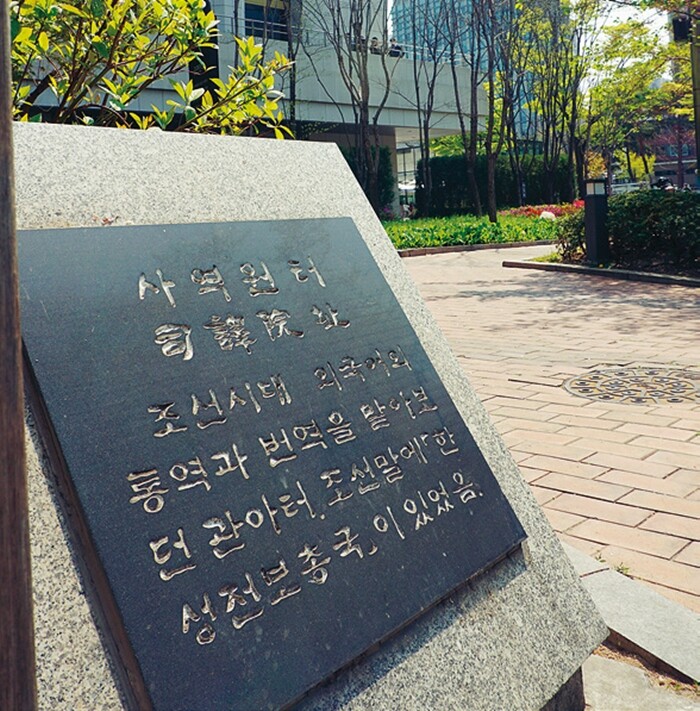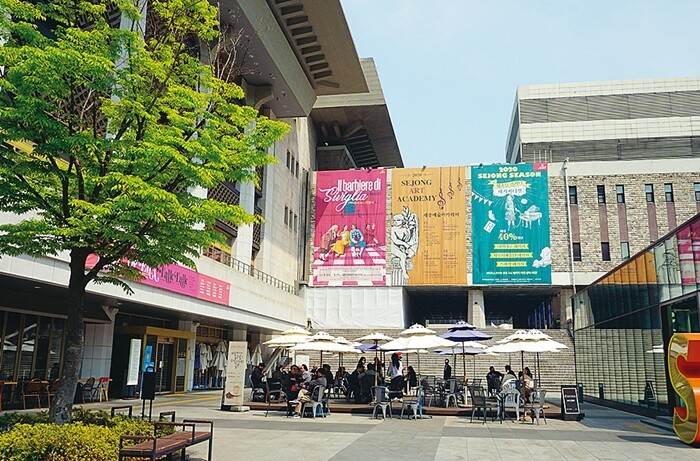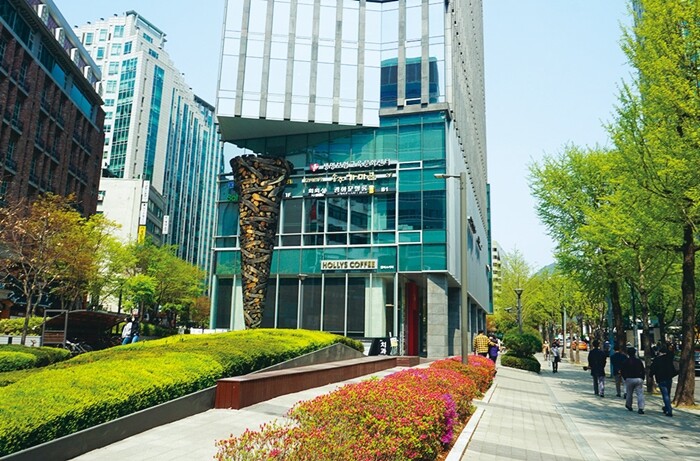hankyoreh
Links to other country sites 다른 나라 사이트 링크
[Seoul travels] Walking in Hamel’s footsteps in the Gwanghwamun area

Telecommuting reminds me of a punishment from the Joseon Dynasty. Political prisoners who were exiled to the provinces were sometimes confined inside a fence made of brambles. That often happened on Jeju Island, where Prince Gwanghae was exiled after being deposed in favor of King Injo. Being confined to our homes because of the COVID-19 pandemic gives us a keen sense of the value of our daily routine.
COVID-19 isn’t the only thing that flings our lives in unexpected directions — typhoons can do the same. That’s what happened to Hendrick Hamel, a Dutch sailor brought to Jeju by a typhoon in 1653. As it happened, Hamel and his shipmates lived in the very place where Prince Gwanghae had been confined on Jeju Island.
The first European to provide a firsthand account of KoreaThanks to some wine, they were allowed to stay in the relatively comfortable accommodations that had housed the prince during his exile on Jeju. What follows is an entry from Hamel’s journal for Aug. 19, 1653: “They took with them a jar of red wine, as well as a silver cup belonging to the Company, which we had found lodged between some rocks, to pour the wine into. Tasting the wine, they liked it very much and they drank so much that they rejoiced greatly.”
Stranded by a typhoon, Hamel and his party gave the first gift of wine on the Korean Peninsula. This Spanish wine was an excellent stand-in for communication, since the Dutchmen and Koreans didn’t speak the same language.
The first Korean to record a recipe for wine and his thoughts on tasting wine was Joseon traveler Lee Gi-ji, who met with European priests in Beijing ten times in 1720. But Hamel’s journal entry is 67 years older than that.
Hamel’s party left Jeju Island and arrived in Seoul on June 26, 1654. Their experience in Seoul is described in a passage from the Records of the Border Defense Council, a powerful government body that determined matters of state.

“The people brought by Jan Jansz Weltevree have just entered Seoul and been ordered to stay in the lodgings of the Bureau of Interpreters. From today, their wages will be calculated, and most of them have been assigned as soldiers on guard duty.”
The Bureau of Interpreters, another government body, was located in Seoul’s Jeokseon neighborhood. Coming out of Exit 6 of Gyeongbokgung Station, on line three of the Seoul subway, and walking past the Ministry of Foreign Affairs, one finds a plaque marking the site of the Bureau of Interpreters in the vicinity of the Sejong Center for the Performing Arts. That was the first lodgings of Hamel’s party when they reached Seoul.
“In the beginning, we hardly could use the narrow streets near where we lived, and even in our homes, the crowds would not give us even a little rest. Finally, the general forbade us to visit anyone who had not received permission from him,” Hamel wrote in his journal.
In the mid-17th century, the area around the Sejong Center became something of a zoo as people gawked at the 35 strapping Europeans who had suddenly appeared.
Hamel was the first Westerner “side street explorer” who wrote about the Joseon Dynasty. The Dutchman Jan Jansz Weltevree had arrived in Joseon 26 years before Hamel, but he didn’t leave any written records.
Life in a foreign landHamel’s party was split up and housed for a while in the homes of Chinese who had fled their homes and settled in Korea. But the owners of their homes demanded that Hamel and his shipmates fetch firewood every day.
Eventually, Hamel’s party sold deer hides that had been recovered from their shipwreck and used the proceeds to buy several small houses that could accommodate two or three people. This episode illustrates the spirit of independence and thrift that are characteristic of the Dutch.
Hamel’s party was under the authority of a military organization called the Military Training Directorate. The initial plan was to take advantage of the Dutchmen’s facility with firearms, but they were soon assigned to guard the king’s litter.
The Military Training Directorate was next to Gyeonghuigung, one of the palaces (along with Changdeokgung) frequented by King Hyojong, who reigned while Hamel was in Korea. The main royal palace of Gyeongbokgung had been burned down during the Japanese invasions of Korea at the end of the 16th century.
A plaque commemorating the Military Training Directorate stands in front of the Crescendo Building, former site of the headquarters of Daewoo Engineering and Construction, next to the Seoul Museum of History.

Mattheus Eibocken, the member of Hamel’s party with the best command of the Korean language, told Dutch writer Nicolaes Witsen following their return to the Netherlands that they’d been given food and even alcohol by the king.
“The Koreans know how to make a reddish drink. It takes rather like wine and has an intoxicating effect. On one occasion, the king served that drink to us Dutchmen in the palace.”
It’s not clear whether Eibocken was referring to azalea wine or wine made of bokbunja, a local variety of raspberry. The Dutchmen were summoned before the king to sing, dance, and play the flute. They also had to carry around identification tags, known as hopae.
Interestingly, Hyojong was the only king of the Joseon Dynasty since it was founded by Lee Seong-gye (later known as Taejo), who had been overseas. While being held hostage by the Manchus for eight years following their invasion of Korea, Hyojong had a front-row seat in the dramatic transition in China from the Ming Dynasty to the Manchu-led Qing Dynasty.
That experience inspired Hyojong to sympathize with the Dutchmen’s plight and to show them numerous kindnesses despite the opposition of his retainers.
But the Dutchmen’s sojourn in Seoul came to an end after one year and nine months because of a surprise incident. When an envoy from the Qing was in town, two of Hamel’s shipmates — Hendrick Janse and Hendrick Janse Bos — caused a disturbance in front of the envoy, hoping he would help them escape.
Interestingly enough, their respective names are recorded in the Journal of the Royal Secretariat as “Nam Buk-san” and “Nam I-an.” The “Nam” surname, which was also given to most of the other members of their party, literally means “south” and was a reference to the “southern barbarians.”
In March 1656, Hamel left Seoul and was transferred to remote Jeolla Province. In all, his sojourn on the peninsula lasted 13 years and 28 days. After sharing a tearful farewell with them at the river ferry, Weltevree (known by the Korean name “Park Yeon”) would marry a Korean woman and father two children with her, a boy and a girl, living out the result of his tumultuous life in a foreign land.
His ancestral line has been carried on by the Wonsan Park clan, which counts a renowned university professor among their number. Eibocken’s account suggests that other members of Hamel’s party also appear to have lived with Korean women.
Looking for markers of Hamel in SeoulHamel’s activities took place in the Gwanghwamun area, behind what is today the Sejong Center. Following in his footsteps, I take Exit 1 from the Gwanghwamun subway station, walking past the Sejong Center and rounding the Four Seasons Hotel toward Saemoonan Presbyterian Church.
In front of what used to be the Daewoo E&C building, I see a marker for the Military Training Directorate. Crossing the street there, I follow the road behind artist Jonathan Borofsky’s “Hammering Man” sculpture. There is a staircase that leads to the old Russian legation building in the Jeong-dong neighborhood, and the Dutch embassy there offers a vestige of the homeland that Hamel so longed to return to. For a person imprisoned, it was a path toward freedom.
Sadly, it is difficult to find any markers of Hamel’s visit anywhere in Seoul. Is it only buildings that deserved to be restored and renewed? Why do we ignore the storytelling resources, which can be so enthralling?
Without the passionate life stories of people, side streets are nothing more than chilly objects. This is something that urgently needs to be reformed.
By Son Kwan-seung, travel writer
Edited by Seoul&
Please direct comments or questions to [english@hani.co.kr]
Editorial・opinion
![[Column] Season 2 of special prosecutor probe may be coming to Korea soon [Column] Season 2 of special prosecutor probe may be coming to Korea soon](https://flexible.img.hani.co.kr/flexible/normal/500/300/imgdb/original/2024/0426/3317141030699447.jpg) [Column] Season 2 of special prosecutor probe may be coming to Korea soon
[Column] Season 2 of special prosecutor probe may be coming to Korea soon![[Column] Park Geun-hye déjà vu in Yoon Suk-yeol [Column] Park Geun-hye déjà vu in Yoon Suk-yeol](https://flexible.img.hani.co.kr/flexible/normal/500/300/imgdb/original/2024/0424/651713945113788.jpg) [Column] Park Geun-hye déjà vu in Yoon Suk-yeol
[Column] Park Geun-hye déjà vu in Yoon Suk-yeol- [Editorial] New weight of N. Korea’s nuclear threats makes dialogue all the more urgent
- [Guest essay] The real reason Korea’s new right wants to dub Rhee a founding father
- [Column] ‘Choson’: Is it time we start referring to N. Korea in its own terms?
- [Editorial] Japan’s rewriting of history with Korea has gone too far
- [Column] The president’s questionable capacity for dialogue
- [Column] Are chaebol firms just pizza pies for families to divvy up as they please?
- [Column] Has Korea, too, crossed the Rubicon on China?
- [Correspondent’s column] In Japan’s alliance with US, echoes of its past alliances with UK
Most viewed articles
- 1‘We must say no’: Seoul defense chief on Korean, USFK involvement in hypothetical Taiwan crisis
- 2N. Korean delegation’s trip to Iran shows how Pyongyang is leveraging ties with Moscow
- 3‘Weddingflation’ breaks the bank for Korean couples-to-be
- 4Korea sees more deaths than births for 52nd consecutive month in February
- 5[Editorial] New weight of N. Korea’s nuclear threats makes dialogue all the more urgent
- 6[Column] Has Korea, too, crossed the Rubicon on China?
- 7[Column] Park Geun-hye déjà vu in Yoon Suk-yeol
- 8[Guest essay] The real reason Korea’s new right wants to dub Rhee a founding father
- 9Amnesty notes ‘erosion’ of freedom of expression in Korea in annual human rights report
- 10[Reportage] On US campuses, student risk arrest as they call for divestment from Israel